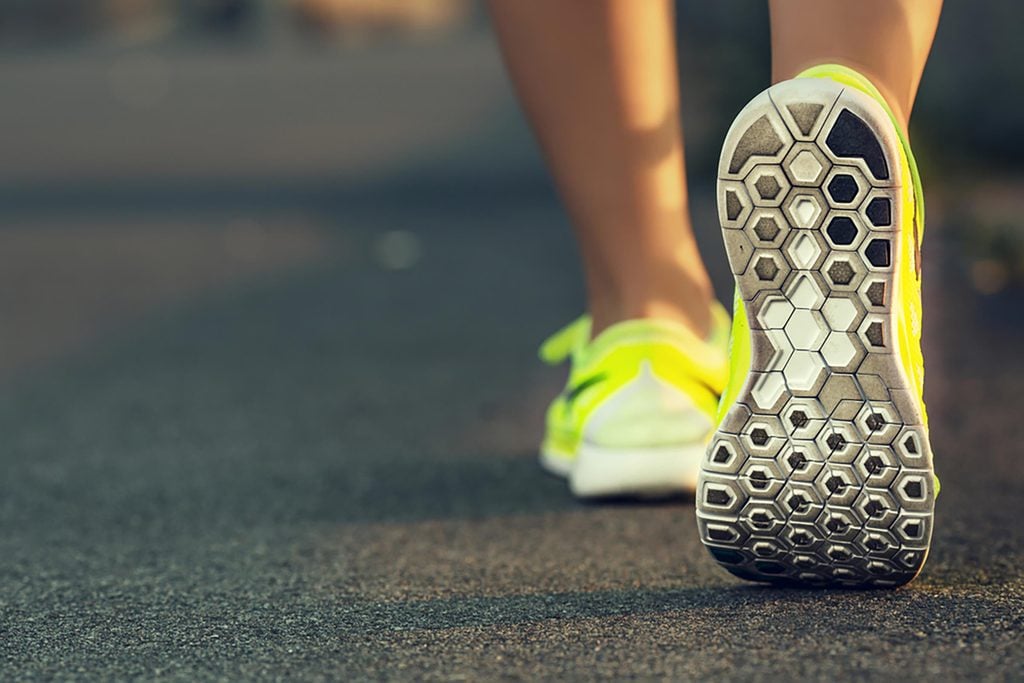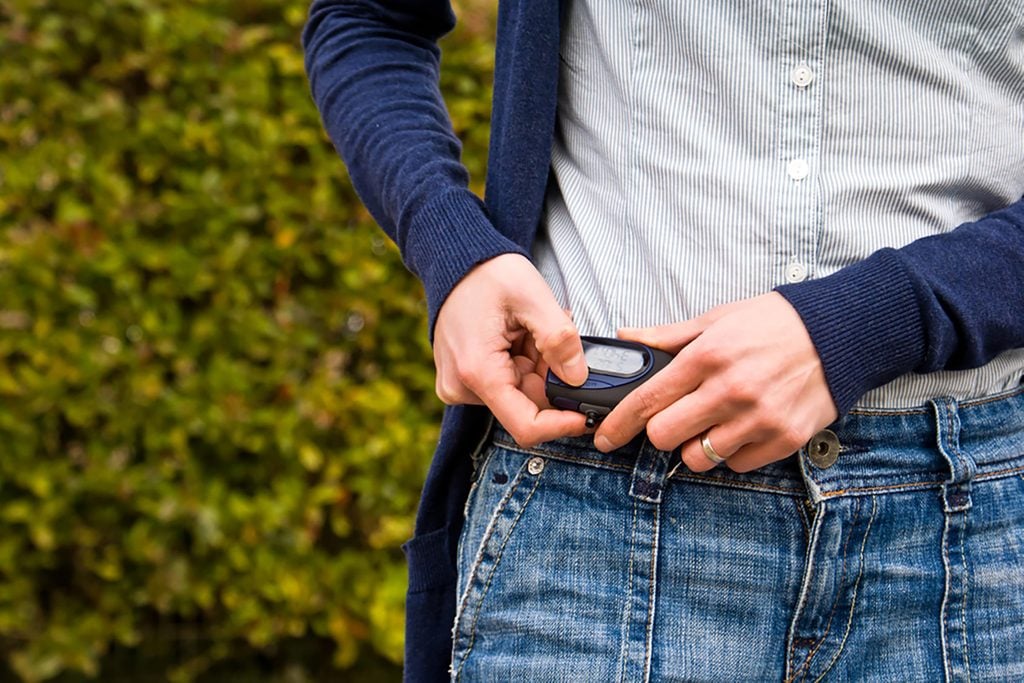10 Reasons You’re Better Off with a Pedometer Than That Fancy Fitness Tracker
Updated: Oct. 17, 2023
Fitness trackers are all the rage, but a simple, inexpensive, pedometer may be all you need to achieve your fitness goals.
They give you a reason to get healthy
One of the biggest motivators for getting a pedometer and starting a fitness regime is to lower your risk of heart disease and stroke. High blood pressure, high cholesterol, and diabetes are all risk factors for heart disease and stroke and you can reduce your chance of getting these conditions simply by walking, briskly. According to the American Heart Association, studies show that walking briskly lowered the risk of high blood pressure, high cholesterol and diabetes as much as running. It’s not difficult to determine what a brisk walk feels like, explains Elroy Aguiar, PhD, Postdoctoral Research Associate at the School of Public Health and Health Sciences at the University of Massachusetts Amherst. “Most people prefer to walk at three miles per hour, a vigorous intensity would be four miles per hour.” While your pedometer or fitness tracker won’t tell you how fast you are moving, you can determine your intensity with the talk-sing test, says Aguiar. If you can talk, but not sing, your activity is moderate intensity, but if you can’t say more than a few words without pausing for breath, then your activity is vigorous.
 You don’t have to wear them on your wrist
You don’t have to wear them on your wrist
From Fitbits to Jawbones, there are numerous fitness trackers on the market. While they are available in a range of colors and styles, the most popular ones are not very fashionable and can become cumbersome to wear. With pedometers, you just clip them on your waistband near your hip, which allows them to remain relatively out of sight, and start walking. Another option is to download a pedometer app, which lets you keep track of your steps from your cell phone.
They are inexpensive
Like fitness trackers, there are several brands and styles of pedometers on the market. Unlike fitness trackers, pedometers cost considerably less. A reliable pedometer will cost anywhere from $15 to $35, with the higher end products boasting extra features such as length of time walked, distance traveled, and an approximation of calories burned. Expect to pay a lot more for a notable fitness tracker such as the Fitbit Charge ($149) or the Apple Watch ($369). “When it comes to fitness trackers and activity monitors, the thing that they do best is count steps,” says Patrick Schneider, Professor of Exercise Science at Belmont University in Nashville, Tennessee. “Steps are the fundamental unit of activity and the number of steps is the data that most people want to know.”
 They can motivate you to be active
They can motivate you to be active
When inactivity takes over and you need help snapping out of your fitness rut, a pedometer can be an inexpensive, effective way to get back on track. “As an entry level motivator or to make people aware of how much they are moving, pedometers do a good job in that most people may be surprised of how little stepping they do,” says Jeffrey W. Christle, PhD, a clinical exercise physiologist (American College of Sports Medicine) in the division of CV medicine at Stanford University. While a step counter by itself does not always provide sufficient motivation, says Mikael Mattsson, visiting professor at Stanford University, “It can be used in gamification of physical activity, such as workplace-based initiatives or in actual games such as Step Jockey,” he explains. Research backs up Mattsson’s claims, as several randomized trials show that a combination of wearing a pedometer and having a goal is most effective. A common goal for many people is to achieve 10,000 steps a day, which is equivalent to about five miles, depending on the length of your stride. Pedometers are good motivators for those who are sedentary, says Schneider. “The people who are doing nothing and start doing something, have the most to gain,” he says. Following the Public Health Guidelines of 30 minutes of moderate-intensity activity every day, at least five days a week is a good place to start.
They won’t make you lose sleep
Experts say that while most fitness trackers can tell when a person is awake versus asleep, they are prone to mistakes and can actually cause people to lose sleep. One study showed that a number of fitness trackers overestimated sleep while another study looked at behavioral problems, noting that some users rely on daily sleep data too much, and if they are not getting the right amount of sleep, it can lead to stress and loss of sleep. While reports show that overestimates of sleep are not harmful to most people, for those with sleeping disorders, the sleep results of their fitness trackers could be giving them false reassurance. “In terms of sleep, quality and length are important, but fitness trackers do not measure quality,” says Aguilar. He explains that because these devices are based on the wrist motion during different cycles of sleep, they are not accurate in determining whether you are asleep or awake. “You could be lying on the couch watching TV and not moving, but the device may think you are sleeping.”
 They’re easy to use
They’re easy to use
A pedometer does one task—counts your steps. Fitness trackers do multiple tasks such as monitoring your sleep, counting calories, and keeping track of how many days you exercised each week. They can also sync with other programs such as My Fitness Pal, connect you to a community of fitness-minded people, log your water intake, and chart how much weight you have lost (or gained). Colorful diagrams display your progress, badges pop up to congratulate you on specific goals, and notifications remind you that you have just a few more steps to go. To keep your fitness tracker and all the information it stores up to date, you have to charge it, sync it to your phone or computer, and input data. The work involved often becomes cumbersome, and surveys have shown that in as little as six months, people lose interest and stop wearing them. “We are in an era where people like gadgets and they like receiving feedback on their health,” says Schneider. “But the interest can wear off.”
They help you set goals
While 10,000 steps a day is the norm, it is a high target to reach for most individuals, says Aguiar. “We know that doing something is better than doing nothing at all, but if you are taking less than 5,000 steps a day, you are sedentary or your occupation is sedentary.” To improve overall cardiovascular health and reduce your risk of heart disease and stroke, the American Heart Association suggests getting at least 150 minutes per week of moderate exercise or 75 minutes per week of vigorous exercise (or a combination of both). One of the easiest ways to reach these goals is by walking and using a pedometer to gauge your steps. “People think vigorous activity is running, but you can achieve this at a regular paced walk or brisk walk, you don’t need to be sweating buckets or charging down the road.”
They won’t miscount your calories
Research has shown that fitness trackers are not accurate when it comes to measuring the amount of calories burned. If your fitness tracker regularly underestimates energy expenditure you might end up feeling frustrated that you are not burning a lot of calories after a hard workout and this can make it difficult to reach your goals. On the other hand, if your fitness tracker overestimates the calories you are using, you could end up overeating and ultimately gain weight. “People don’t lose weight by exercising, they lose weight by not eating so much,” says Gerald Fletcher, MD, cardiologist at the Mayo Clinic in Jacksonville, Florida. While a pedometer can be a good tool to get people started with following a healthy lifestyle, explains Fletcher, they don’t need a piece of equipment or a gadget to exercise. “When it comes to exercise and staying healthy, the biggest obstacle people need to overcome is making excuses.”
 You won’t rely on them to track your heart rate
You won’t rely on them to track your heart rate
Even though one of the best ways to track your heart rate accurately is to take your pulse, fitness trackers purport to make things easier by using something called photoplethysmography to detect heart rate, explains Aguiar, and this technology is generally good when you’re at rest, but not once you start exercising—they just aren’t as accurate. “They are slow to react, the device may lag, and it may never actually display the heart rate that you are achieving.” The motion of your wrist, the amount you sweat, and how you wear the band on your wrist can all affect the accuracy of the heart rate monitor says Aguiar. He recommends the Polar Heart Rate Sensor, which straps across your chest, over fitness trackers. “Expensive trackers are a waste of money and time,” says Fletcher. “People can be told how to take their pulse.” While heart rate is important, says Fletcher, it’s also important to know your perceived exertion, and determine how hard your body is really working.
There’s no magic bullet for weight loss
One study found that when people on a weight-loss program were told to either wear a fitness tracking device or not, those who didn’t wear one lost more weight the fitness tracker group. While fitness trackers and pedometers serve as tools to keep people focused on maintaining a healthy lifestyle, sustainable behavior is the key, says Schneider. “The real challenge is finding an activity that you like to do and then keep doing it.”











